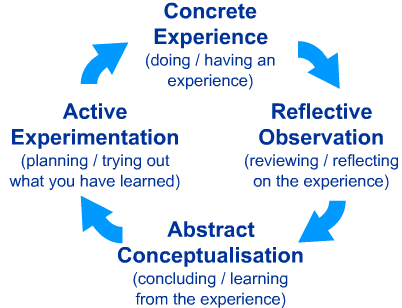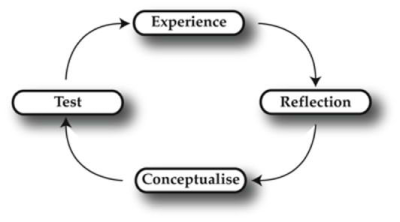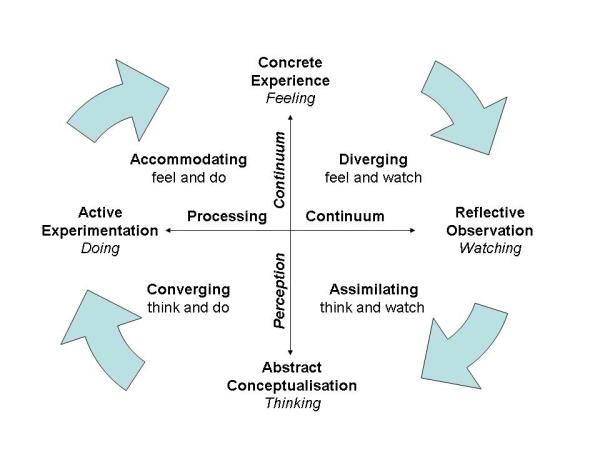Kolb’s Experiential Learning Style Model
This is the first model of learning style that we’ve discussed. The course site forum regarding this was very enriching from which many perspectives were presented that led to better understanding of the concepts.
Simply put, experience determines learning. Knowledge is the result of a dual process: grasping and transforming experience (Kolb, 1984). So, as defined by David Kolb, “Learning is the process whereby knowledge is created through the transformation of experience.”
David Kolb actually published his learning styles model in 1984 from which he developed his learning style inventory. David Kolb’s model emphasizes the learner’s internal cognitive processes as they are involved in experiential learning. A person’s preference is influenced by several factors, among which are the social environment, learning experiences, and the person’s prior knowledge and skills.
Kolb states that learning involves the acquisition of abstract concepts that can be applied flexibly in a range of situations. In Kolb’s theory, the impetus for the development of new concepts is provided by new experiences.
The Experiential Learning Cycle
Kolb’s experiential learning style theory is typically represented by a four stage learning cycle in which the learner ‘touches all the bases
1. Concrete Experience
-a new experience of situation is encountered, or a reinterpretation of existing experience
2. Reflective Observation
-observation of the new experience
-of particular importance are any inconsistencies between experience and understanding
3. Abstract Conceptualization
-reflection gives rise to a new idea, or a modification of an existing abstract concept
4. Active Experimentation
-the learner applies them to the world around them to see what results
To better understand the cycle that Kolb is referring to, the picture below illustrates the concepts of his learning style:
Effective learning is seen when a person progresses through a cycle of four stages: of (1) having a concrete experience followed by (2) observation of and reflection on that experience which leads to (3) the formation of abstract concepts (analysis) and generalizations (conclusions) which are then (4) used to test hypothesis in future situations, resulting in new experiences.
Kolb (1975) views learning as an integrated process with each stage being mutually supportive of and feeding into the next. It is possible to enter the cycle at any stage and follow it through its logical sequence. However, effective learning only occurs when a learner is able to execute all four stages of the model. Therefore, no one stage of the cycle is an effective as a learning procedure on its own.
To summarize all the above concepts, we can have it said that:
Four learning modes in Kolb’s model
- Concrete Experience (CE)
– “FEELING” experiential encounter with a new situation or a reinterpretation of existing experience
- Abstract Conceptualization (AC)
– “THINKING” modification of an existing abstract concept or creation of new ideas through reflection
- Active Experimentation (AE)
– “DOING” explore outcomes through application to real-world situations
- Reflective Observation (RO)
– “WATCHING” thoughtful scrutiny, on the lookout for inconsistencies between experience and understanding
A typical presentation of Kolb’s two continuums is that the east-west axis is called the Processing Continuum (how we approach a task), and the north-south axis is called the Perception Continuum (our emotional response, or how we think or feel about it).
Kolb believed that we cannot perform both variables on a single axis at the same time (e.g. think and feel). Our learning style is a product of these two choice decisions.
It’s often easier to see the construction of Kolb’s learning styles in terms of a two-by-two matrix. Each learning style represents a combination of two preferred styles. The diagram also highlights Kolb’s terminology for the four learning styles; diverging, assimilating, and converging, accommodating:
| Doing (Active Experimentation – AE) | Watching (Reflective Observation – RO) | |
| Feeling
(Concrete Experience – CE) |
Accommodating (CE/AE) | Diverging (CE/RO) |
| Thinking (Abstract Conceptualization – AC) | Converging (AC/AE) | Assimilating (AC/RO) |
Learning Styles Descriptions
Knowing a person’s (and your own) learning style enables learning to be orientated according to the preferred method. That said, everyone responds to and needs the stimulus of all types of learning styles to one extent or another – it’s a matter of using emphasis that fits best with the given situation and a person’s learning style preferences.
Here are brief descriptions of the four Kolb learning styles:
Diverging (feeling and watching – CE/RO)
These people are able to look at things from different perspectives. They are sensitive. They prefer to watch rather than do, tending to gather information and use imagination to solve problems. They are best at viewing concrete situations several different viewpoints.
Kolb called this style ‘diverging’ because these people perform better in situations that require ideas-generation, for example, brainstorming.
Assimilating (watching and thinking – AC/RO)
The Assimilating learning preference is for a concise, logical approach. Ideas and concepts are more important than people. These people require good clear explanation rather than practical opportunity. They excel at understanding wide-ranging information and organizing it a clear logical format.
Converging (doing and thinking – AC/AE)
People with a converging learning style can solve problems and will use their learning to find solutions to practical issues. They prefer technical tasks, and are less concerned with people and interpersonal aspects. People with a converging learning style are best at finding practical uses for ideas and theories. They can solve problems and make decisions by finding solutions to questions and problems.
Accommodating (doing and feeling – CE/AE)
The Accommodating learning style is ‘hands-on’, and relies on intuition rather than logic. These people use other people’s analysis, and prefer to take a practical, experiential approach. They are attracted to new challenges and experiences, and to carrying out plans. They commonly act on ‘gut’ instinct rather than logical analysis.
So upon analysis of this first learning style, what specific category would best describe you as a learner? 😀
Reference:
Saul McLeod. Kolb-Learning Styles. Retrieved June 8, 2013 from http://www.simplypsychology.org/learning-kolb.html


